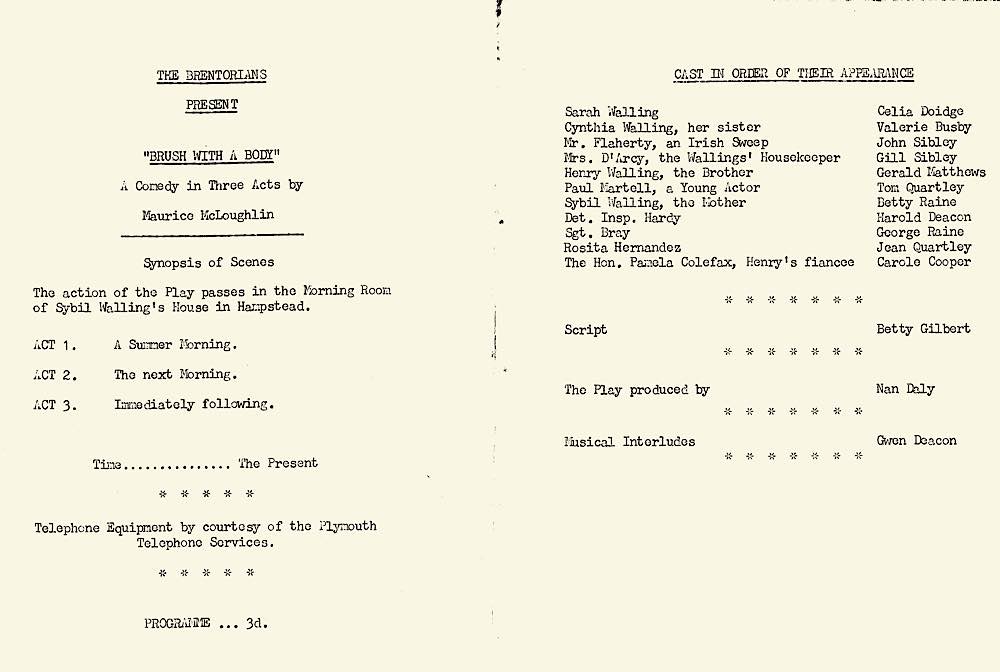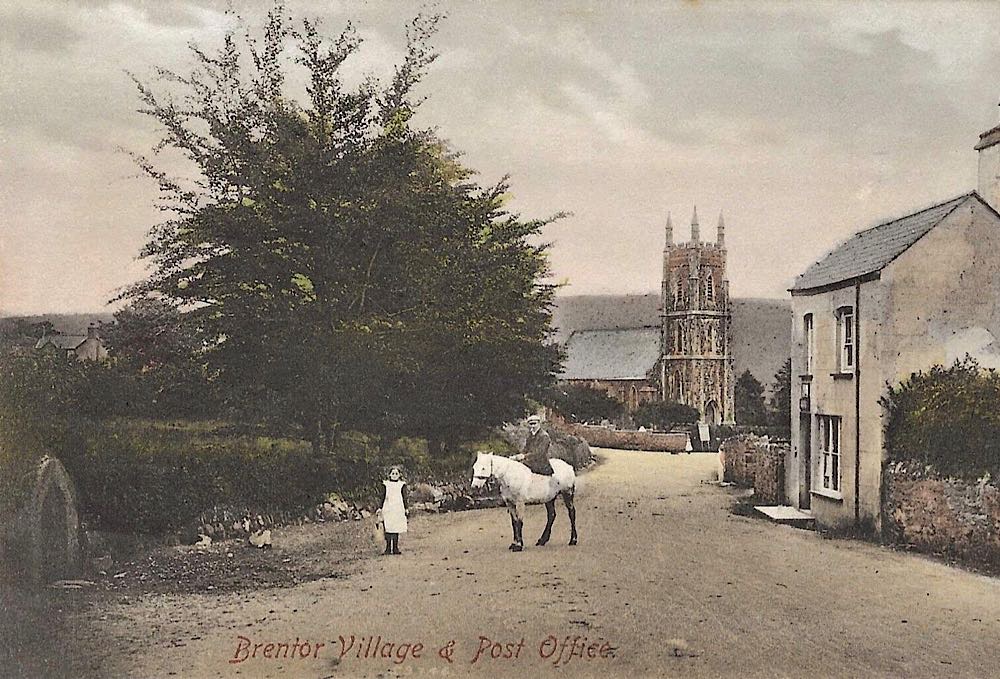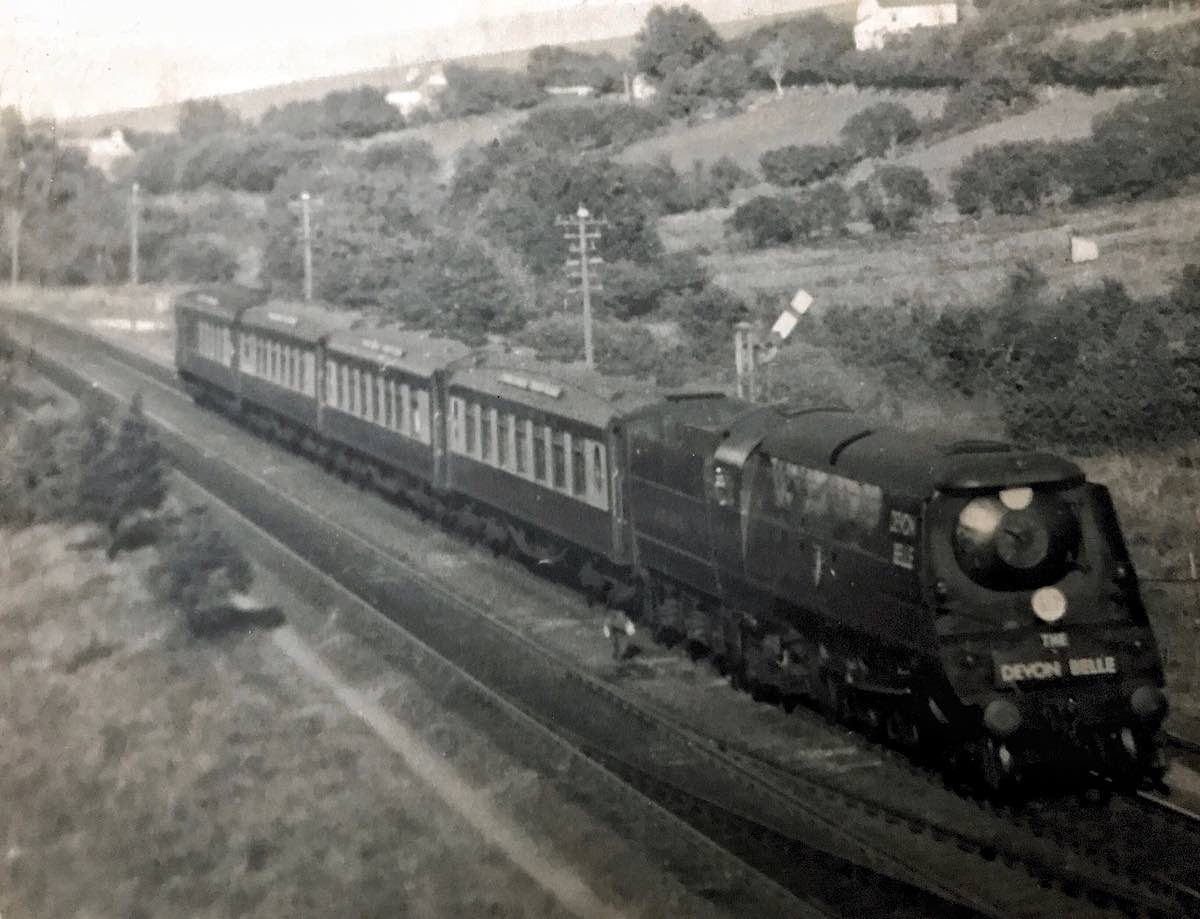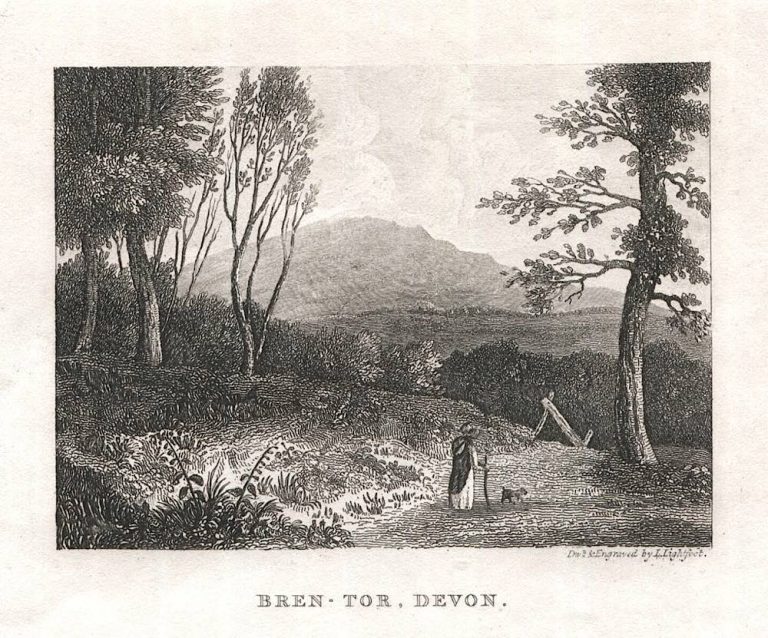If you have an interesting photograph of Brentor why not send it to the editor at editor@brentorpc.org.uk for ‘Picture of the month’ and as an addition to the Brentor Living Archive.
A Brentor family photo at Crossways
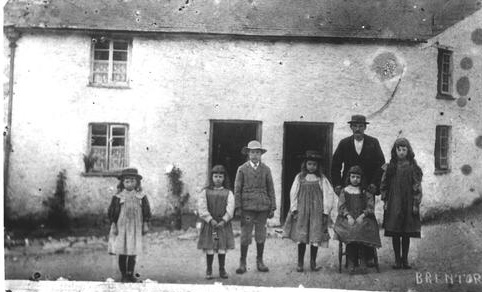 This photograph was taken in the 1890s. The group are pictured in front of Crossways, the house that was Downing's butcher's shop in North Brentor village until the 1990s . The photographer was standing on the present location of the Brentor War Memorial, before it was installed after the end of WW1.
This photograph was taken in the 1890s. The group are pictured in front of Crossways, the house that was Downing's butcher's shop in North Brentor village until the 1990s . The photographer was standing on the present location of the Brentor War Memorial, before it was installed after the end of WW1.
This is one of many photographs in the Brentor Living Archive and was copied from the original owned by the Downing family.
The Brentorians in 1967
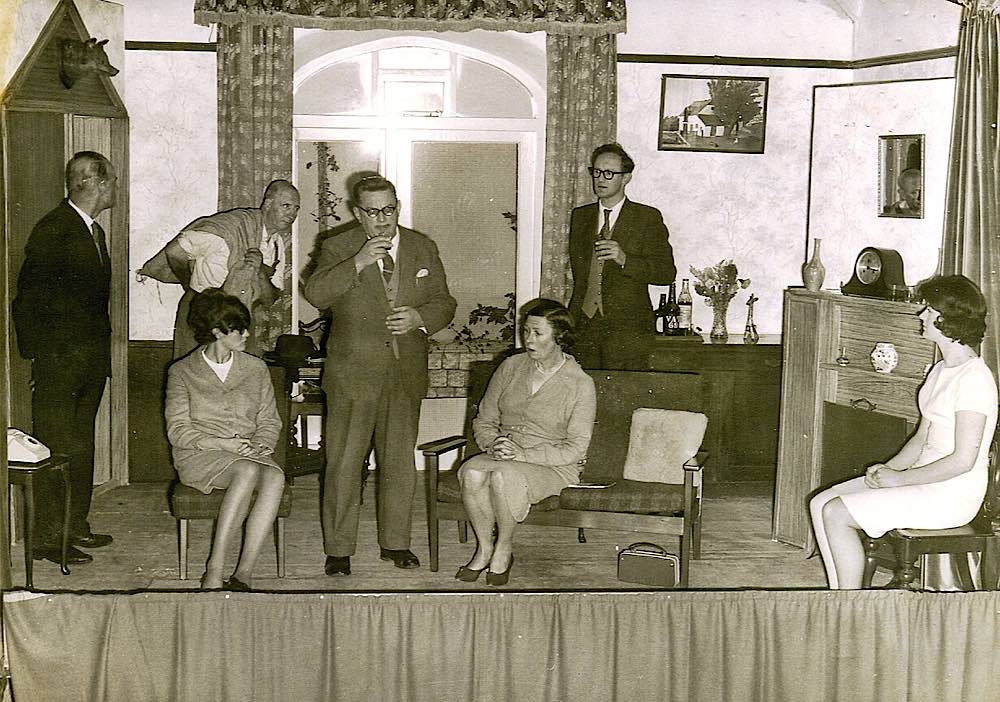 The Brentorians in 1967, performing the comedy ‘Brush with a Body’ by Maurice McLoughlin. Photo courtesy of Carol Butson.
The Brentorians in 1967, performing the comedy ‘Brush with a Body’ by Maurice McLoughlin. Photo courtesy of Carol Butson.
The Brentorians performed in the Village Hall, at that time in the former school in Church Lane, adjacent to Christchurch. The building was sold in the early 2000s and is now a private house called The Old School House.
The performers are, from left to right, George Raine, Carol Cooper (seated), John Sibley (with sack), Harold Deacon, Betty Raine (seated), Gerry Mathews, and Val Busby (seated). Thank you to Judy Baxter for identifying them.
Liddaton Halt
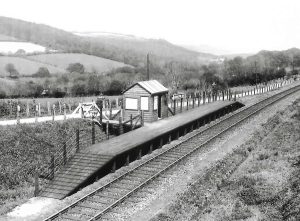 Liddaton Halt was a tiny railway station opened on 4th April 1938 by the Great Western Railway on the Launceston and South Devon branch line. It was to serve the hamlet of Liddaton and opened much later than most other stations on the railway line from Plymouth to Launceston, which had started operating in 1865.
Liddaton Halt was a tiny railway station opened on 4th April 1938 by the Great Western Railway on the Launceston and South Devon branch line. It was to serve the hamlet of Liddaton and opened much later than most other stations on the railway line from Plymouth to Launceston, which had started operating in 1865.
The single platform was a wooden structure with a small wooden passenger shelter, originally lit by a single oil lamp. There was a single platform name board. A bridge carrying the lane from Liddaton to Coryton over the line was situated at the Tavistock end of the platform and still exists today near Broad Park. The railway was a single track with no passing loops or sidings.
This photograph was probably taken in the 1950s from the bridge.
From 1st May 1953, on weekdays and Sundays, 'where train service permits', cheap day return tickets, first and third class, were available:
To Launceston or Tavistock South station
cost 3/6d (17.5p) first class, 2/3d (11p) third class.
To Plymouth North Road Station
cost 8/9d (43p) first class, 5/9d (28p) third class.
The Halt was closed to passengers on 31st December 1962.
This photograph is one of several recently sent to the editor by Sue Swanborough and will be added to the Brentor Living Archive collection.
North Brentor Village Centre, about 1910
The centre of North Brentor village centre has changed remarkably little since the time when this photograph was taken – probably around 1910.
Windsor Cottage, on the right, was the village Post Office. There is no telephone box and a complete lack of telephone and power cables that now crisscross the sky. Transport was mainly by horse, so no parked vehicles! The village water supply was from the spring in the wall to the left – local people regularly did their washing there.The church, Christchurch, was opened in 1857 as a ‘chapel of ease’ for those who found it difficult to get to St.Michaels on Brent Tor. The cost of £1,003 was covered largely by Isabella Holwell (then owner of the property now called Bonnaford), who made a bequest in her will towards building the new chapel.
The field to the left was in private ownership – it is now known as ‘The Eastcott Memorial Field’ and was purchased in 1979 by the Brentor Parochial Church Council from the proceeds of two half shares in other local fields given by the late Mrs Eastcott of Windsor Cottage, the village postmistress. It was agreed that the field should be preserved from any development and kept for the benefit of the village. Most of the field is still grazed but part of it was landscaped with help from Dartmoor National Park to provide a village wildlife pond and a ‘pocket park’ for the use of local residents. The income from the rent of the field was to be used for the maintenance of the pocket park.
You can find out more about the Eastcott Memorial Field by clicking here.
Photograph courtesy of Sue Swanborough.
The Devon Belle Pullman
This photograph shows the 'Devon Belle' Pullman train about to pass under the (now demolished) bridge under Station Road near Brentor station, some time between 1947 and 1950. West Blackdown and Gibbet Hill is in the background.
The service between London Waterloo and Ilfracombe, with a portion of the train travelling on to Plymouth, did not last for long as a named train service. It was introduced by the Southern Railway on 20th June 1947 and continued until September 1954. The train travelled from London to Exeter with a ‘Merchant Navy class’ Pacific engine. Four coachs went on to Plymouth through Brentor and the remaining eight or ten went north to Ilfracombe. It was the only ‘non stop’ service between Waterloo to Exeter.
With a decline in passenger numbers, from 1950 the Plymouth section ceased and the final Devon Belle service to Ilfracombe was run in September 1954.
Photograph courtesy of Tony Dommett, whose grandfather Charles Dommett, who may have taken the photograph, lived in 2 Station View and worked on the railway.
West Blackdown, probably 1940s
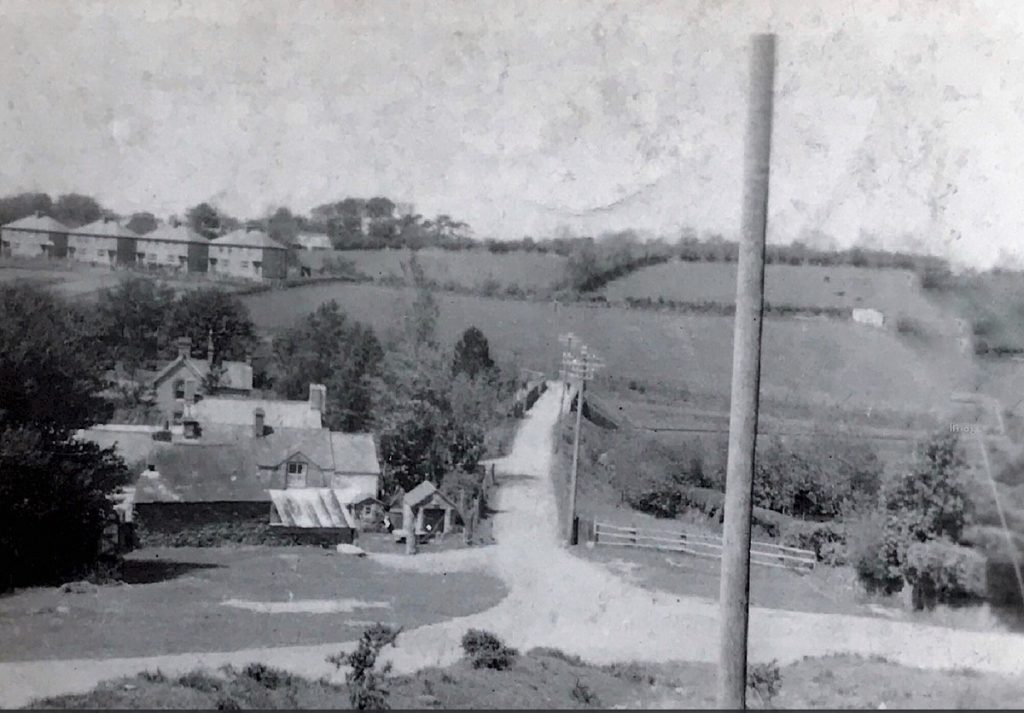 This photograph shows the West Blackdown end of Station Road, which appears to be a fairly rough track.
This photograph shows the West Blackdown end of Station Road, which appears to be a fairly rough track.
There is no sign of the cattle grid that now exists, so livestock from the moor must have been free to wander into the village. Woodgord house is to the left, with Brentor Station behind it. Station View, then known as Council Houses, is to the rear on the left.
Photograph courtesy of Tony Dommett, whose grandparents Charles and Laura Dommett lived in 2 Station View (then called 2 Council Houses) from the 1930s. Laura Dommett was still in Station View in the 1980s and took an active part in village life.
Brent Tor by L. Lightfoot, about 1838
This small antique print, only 10cm wide, shows a woman and dog, with Bren Tor in the background and foxgloves in the foreground. St Michael's church on the top of the tor can only just be seen in through the mist.
It was drawn and engraved by L. Lightfoot and originally produced for Thomas Dugdale’s part-work survey published as 'The Curiosities of Great Britain' or 'England Delineated' between 1838 and 1860.

